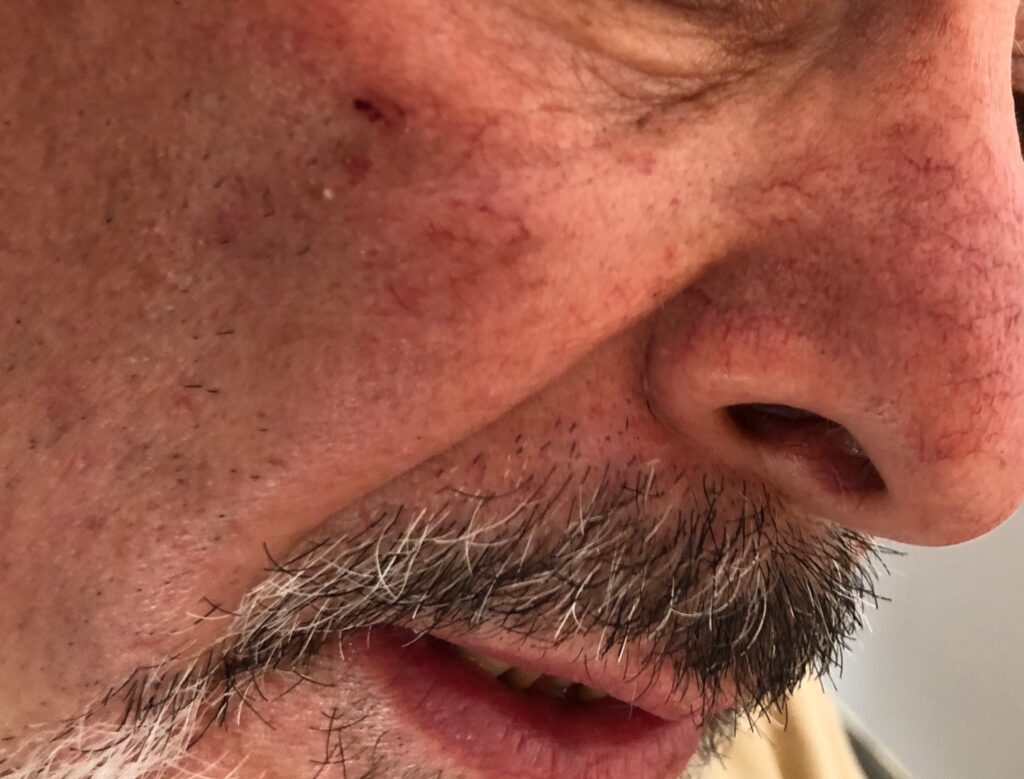- This is, by far, the most common form.
- Rosacea is a benign chronic pathology that progresses in flare-ups and is clinically diagnosed.
- Erythematotelangiectatic rosacea (or rosacea) is a form of rosacea that is characterized by diffuse redness (erythema) and telangiectasia (visible dilation of small blood vessels) mainly on the cheeks, nose, forehead and chin. Laser treatment is often recommended for this form of rosacea, as it effectively reduces redness and dilated vessels.

Erythematotelangiectatic rosacea or rosacea
The treatment of erythematotelangiectatic forms is based on a combination of general measures and hygienic and dietary rules :
- Avoid oily topicals and occlusive foundations;
- Avoid any massage or exfoliation of the skin;
- Wash in warm water with application of a fluid emollient;
- Photoprototection;
- Avoid hot, spicy foods and alcohol;
- Avoid the practice of sports with intense physical effort, baths that are too hot, exposure to heat sources;
- Avoidance of topical corticosteroids (contraindicated).
Erythematotelangiectatic rosacea does not respond to medical treatments. In case of major discomfort, physical methods (especially laser) are possible.
Papulopustalous Rosacea
In papulopustular rosacea, medical treatments are possible. But no cure is known and no treatment is consistently effective on all symptoms. Treatments aim to reduce unpleasant disorders, improve the appearance of the skin and reduce the risk of aggravation.
In the so-called minor forms of papulopustalous rosacea, the treatment is primarily local. It is based on the application of topical treatments, most often starting with metronidazole 0.75% topical (twice-daily applications for 3 months) or ivermectin 10mg/g topical (one application per day for 3 months).
In the so-called profuse forms of papulopustalous rosacea, i.e. combining intense redness and numerous papulo-pustules (more than 10 lesions), doxycycline at a dose of 100 mg per day in the evening is often used as a 1st line for 3 months in combination with local treatment.
Types of lasers used for rosacea (erythematotelangiectatic rosacea)
Erythematotelangiectatic rosacea (or rosacea) is a form of rosacea that is characterized by diffuse redness (erythema) and telangiectasia (visible dilation of small blood vessels) mainly on the cheeks, nose, forehead and chin. Laser treatment is often recommended for this form of rosacea, as it effectively reduces redness and dilated vessels.
Types of lasers used for rosacea (erythematotelangiectatic rosacea):
- Pulsed Dye Laser (PDL):
- It is the most common laser used to treat rosacea. It targets the dilated blood vessels responsible for redness by emitting light absorbed by the hemoglobin in the vessels. This results in the destruction of the vessels without damaging the surrounding tissue.
- Result : Visible reduction of redness and reduction of telangiectasias after a few sessions.
- Laser Nd:
- This longer-wavelength laser penetrates deeper than PDL and is often used to treat larger or deeper vessels. It is effective in reducing visible telangiectasias and persistent redness.
- Result : Reduction of redness and deeper, more resistant dilated vessels to other treatments.
- Intense Pulsed Light (IPL):
- Although it is not a laser, IPL is widely used to treat rosacea. It emits broad spectrums of light that target diffuse redness and blood vessels. It is a good choice for treating both erythema (diffuse redness) and telangiectasias.
- Result : Gradual reduction of generalized redness and visible blood vessels with an overall effect on skin texture and tone.
Benefits of laser treatment for erythematotelangiectatic rosacea:
- Reduction of persistent redness (erythema):
- Vascular laser (PDL and Nd) makes it possible to specifically target the dilated vessels responsible for redness, providing an effective solution for patients suffering from moderate to severe rosacea. This improves the overall appearance of the complexion.
- Reduction of telangiectasias :
- Telangiectasias are often difficult to treat with topical methods. Lasers allow them to be treated directly by targeting the small blood vessels under the skin, offering visible results from the first sessions.
- Overall Aesthetic Improvement :
- Laser treatment is not limited to reducing blood vessels, it can also stimulate collagen production, improving skin texture and reducing superficial scars or blemishes.
- Long-lasting effect with low risks :
- Although maintenance treatments may be necessary, the results are often long-lasting. The treatment is non-invasive and the side effects are usually mild and temporary (redness, moderate swelling).
- Rapid and minimally invasive treatment :
- Sessions are relatively short, typically 15 to 30 minutes, and there is no significant downtime, allowing patients to quickly return to their daily activities.
Precautions and side effects:
- Temporary redness and swelling : Right after the session, localized redness or swelling may appear, but it disappears within a few hours or days.
- Purpura (temporary bruising): After PDL laser treatment, small bruises may form on the treated areas, but they disappear in about a week.
- Photosensitivity : It is important to avoid sun exposure before and after the treatment, as the skin can become more sensitive to UV rays.
Results and follow-up:
Maintenance : Patients with rosacea may require maintenance sessions once or twice a year, as rosacea is a chronic disease and redness may return.
Number of sessions : In general, several sessions are necessary to obtain optimal results, often between 3 and 5 sessions spaced several weeks apart.
